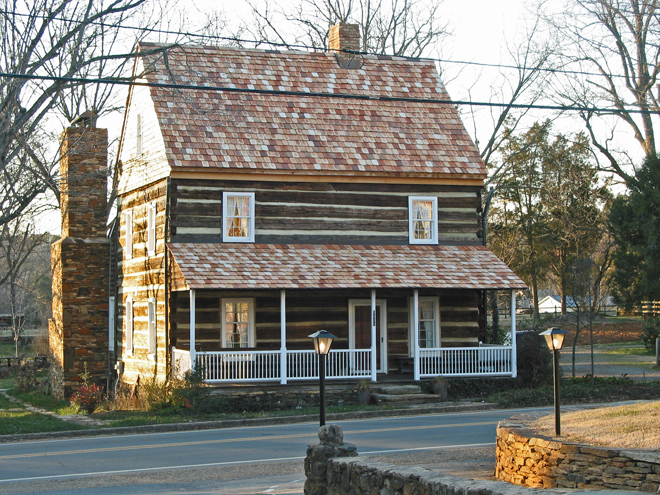J
A
C
O
B
L
O
E
S
C
H
H
O
U
S
E
Robert Pearl Antiques
Southern Antiques and House Restoration
In 2006, a fire occurred at the restored Jacob Loesch House on Main Street in Bethania, North Carolina. I had previously helped in some minor ways with the restoration of the house around 1982 and have known Bob and Alice Adams, owners of the home, for many years through the antiques business. Having heard of the fire, I offered my help in whatever capacity needed. I was given the job of overseeing the historical integrity of the restoration project. Being somewhat of a perfectionist, I felt it necessary to do as much of the work myself as possible.
The person who originally restored the log frame in 1982 was Kevin Thomas, also fondly referred to as the "Log Whisperer". Kevin was called in to assist in restoring the fire damaged logs. So Kevin, his crew, and I began the restoration process in February of 2007. We went about removing the charred remains of the second floor and the burnt-out floor of the attic room. It was my job to determine what could be saved and what had to go.
Kevin proceeded to remove the charred face of the inside of the logs by hewing them down three inches. Antique logs that I had found in a barn in Iredell County, NC where sawn in half, making two facings of approximately three inches thick, which Kevin then veneered to the hewed off interior logs. The chinking was replaced and the results were truly amazing.
Jacob Loesch House as it looked after the fire

After the log work was completed, a plan to replace the shingled roof with a 12/12 pitch pottery roof was formulated. This type of roof was used in the early houses of Bethania and original pottery tiles were found in the attic. These tiles were taken to Star Kilns in Star, North Carolina and matched by size and color. The extra weight was accounted for in the framing of the roof. A laser was used to mark level points at the corners of the house. A string line was pulled across the length of the house front and back as a reference point to level the new plate. This allowed us to clear the rafter ends of the old roof, lay a new section of plate, and frame the new roof over the existing roof, never exposing the house structure below to the elements. Then the old roof was removed.
Now the interior had to be addressed. This was solely my task and I started by using a soda blaster to remove the soot filled pitch that had covered the entire second floor. A soda blaster is specifically built to shoot baking soda under high pressure to remove a thin layer, less than 1/16th of an inch in our case. It is odor absorbent and penetrates the wood. Bryan Adams, the owner's son, helped me wash everything down after blasting, which liquefied the soda in the wood. It amplified the pungent burnt odor. The next day, after the wood had dried (near 100 degree temperatures) the burned odor was completely gone. We had our original unpainted boards with no odor and original patina saved.
During the soda blasting, windows and doors were being reproduced. The green colored vertical walls are period walls from another house with a few boards added and the paint matched. Some patches had to be made to the floor.The blue walls are both original and period replaced boards that I painted and then aged the paint. The floors were finished by Alice Adams. She also cleaned the downstairs.

Bob Adams, never having set foot in the house since the fire, always knew what part of the house I was working on and how the job was being completed. I don't think any of us expected the house to regain it's original status. However, some say it is even better now than it was before.
Jacob Loesch House, October 2008
Risen from the flames...

























